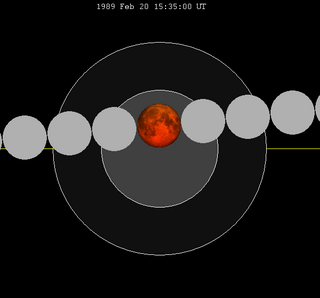
A total lunar eclipse took place on Friday, February 9, 1990, the first of two lunar eclipses in 1990.

A partial lunar eclipse took place on Thursday 5 July 2001, the second of three lunar eclipses in 2001. The Earth's shadow on the moon was clearly visible in this eclipse, with 49.614% of the Moon in shadow; the partial eclipse lasted for 2 hours, 40 minutes and 0.5 seconds. Occurring only 3.9 days before apogee, the Moon’s apparent diameter was 5.021% smaller than average.

A total lunar eclipse took place on Monday, February 20, 1989, the first of two total lunar eclipses in 1989.

A partial lunar eclipse took place on Monday, March 24, 1997, the first of two lunar eclipses in 1997.

A penumbral lunar eclipse took place on Sunday, January 31, 1999, the first of two lunar eclipses in 1999.

A penumbral lunar eclipse took place at the Moon's ascending node on 11 February 2017, the first of two lunar eclipses in 2017. It was not quite a total penumbral lunar eclipse. It occurred the same day as comet 45P/Honda–Mrkos–Pajdušáková made a close approach to Earth. It also occurred on the Lantern Festival, the first since 9 February 2009. Occurring only 4.4 days after perigee, the moon's apparent diameter was larger.

A total lunar eclipse will take place on August 7, 2036. The southern tip of the Moon will pass through the center of the Earth's shadow. This is the last central lunar eclipse of Saros cycle 129.
A partial lunar eclipse took place on Saturday, June 25, 1983, the first of two lunar eclipses in 1983 with an umbral eclipse magnitude of 0.33479. A partial lunar eclipse happens when the Earth moves between the Sun and the Full Moon, but they are not precisely aligned. Only part of the Moon's visible surface moves into the dark part of the Earth's shadow. A partial lunar eclipse occurs when the Earth moves between the Sun and Moon but the three celestial bodies do not form a straight line in space. When that happens, a small part of the Moon's surface is covered by the darkest, central part of the Earth's shadow, called the umbra. The rest of the Moon is covered by the outer part of the Earth's shadow called the penumbra. The Earth's shadow on the moon was clearly visible in this eclipse, with 33% of the Moon in shadow; the partial eclipse lasted for 2 hours and 15 minutes.
A penumbral lunar eclipse took place on Tuesday, January 20, 1981, the first of two lunar eclipses in 1981. In a rare total penumbral eclipse, the entire Moon was partially shaded by the Earth, and the shading across the Moon should have been quite visible at maximum eclipse. The penumbral phase lasted for 4 hours and 24 minutes in all, though for most of it, the eclipse was extremely difficult or impossible to see. The moon's apparent diameter was larger because the eclipse occurred 5.2 days after perigee.

A partial lunar eclipse occurred on the 16 and 17 July 2019. The Moon was covered 65.31% by the Earth's umbral shadow at maximum eclipse.
A partial lunar eclipse took place on Tuesday, March 13, 1979, the first of two lunar eclipses in 1979. The Moon was strikingly shadowed in this deep partial eclipse which lasted 3 hours, 17 minutes and 40.6 seconds, with 85.377% of the Moon in darkness at maximum.

A total lunar eclipse took place on Wednesday, October 18, 1967, the second of two total lunar eclipses in 1967, the first being on April 24, 1967.

A partial lunar eclipse took place on Monday, June 14, 1965. At maximum eclipse, a small bite out of the Moon should have been visible. The eclipse lasted for 1 hour and 40 minutes, with just 18% of the Moon in shadow at maximum.

A total lunar eclipse will take place on January 1, 2048. It will be the first recorded lunar eclipse to be visible on New Year's Day for nearly all of Earth's timezones. The next such eclipse will occur in 2094.

A total lunar eclipse will take place on September 7, 2044. It will be the first total eclipse in Lunar Saros 138.

A total lunar eclipse will take place on August 18, 2054.

A total lunar eclipse will take place on September 8, 2090.

A total lunar eclipse will take place on February 11, 2055.

A total lunar eclipse will occur on Sunday, February 22, 2054.

A total lunar eclipse will occur on Wednesday, June 9, 2123, with maximum eclipse at 05:06 UTC. A dramatic total eclipse lasting 106 minutes and 6 seconds will plunge the full Moon into deep darkness, as it passes right through the centre of the Earth's umbral shadow. While the visual effect of a total eclipse is variable, the Moon may be stained a deep orange or red colour at maximum eclipse. This will be a great spectacle for everyone who sees it. The partial eclipse will last for 3 hours and 56 minutes in total. The penumbral eclipse lasts for 6 hours and 14 minutes. Maximum eclipse is at 05:06:28 UT. This will be the longest Total Lunar Eclipse since 16 July 2000, and the longest one until 12 May 2264 and 27 July 3107, though the eclipse on June 19, 2141 will be nearly identical in all aspects. This will also be the longest of the 22nd century and the second longest of the 3rd millennium. The eclipse on June 19, 2141 will be the second longest of the 22nd century and the third longest of the third millennium.






















































